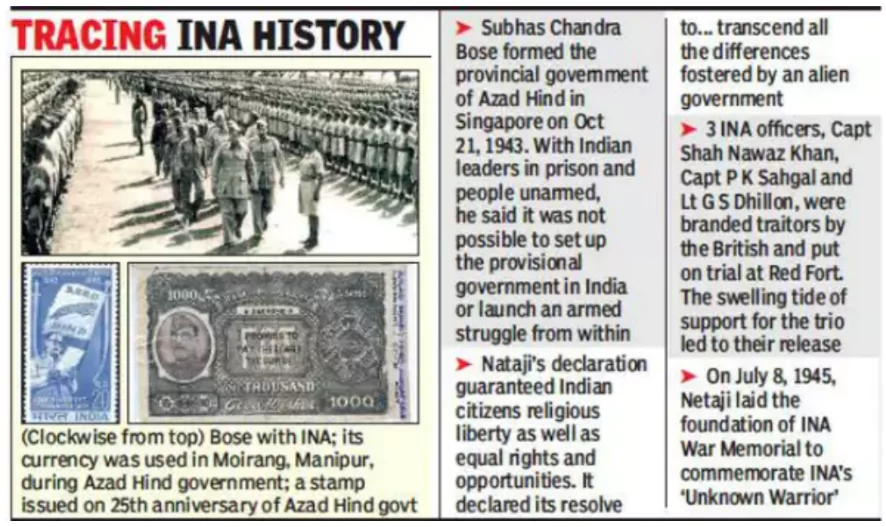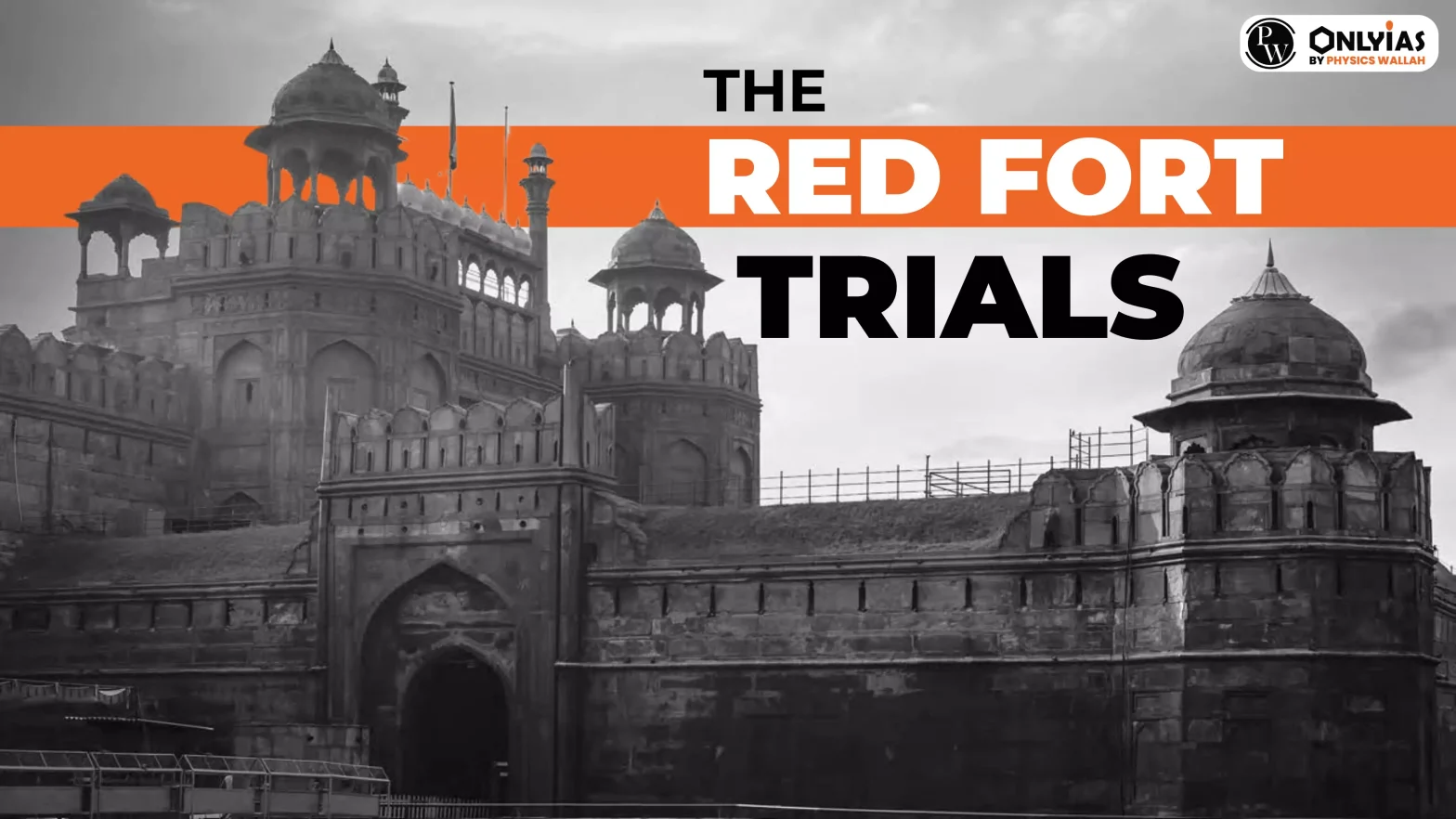Decades after the Red Fort trial, it is hoped that India’s leaders find the wisdom to commit themselves again to what unites us citizens as a people.
- The Red Fort trials, held in 1945-46, were a significant event in India’s struggle for independence.

About Red Fort Trials
The Red Fort Trials, also known as the Indian National Army trials or the INA trials.
- Background:
- The Indian National Army (INA), led by Subhas Chandra Bose, was formed during World War II with the support of Japan to fight against British rule in India.
- Many soldiers from the British Indian Army joined the INA.
- However, after the war, the British captured several soldiers, INA officers and decided to put them on trial for treason, murder and other charges.
- The historic court martial commenced on November 5, 1945.
- Trial at Red Fort: The decision was made to hold a public trial, and it was decided to hold these at the Red Fort.
- Time Period: These were a British Indian court-martial held between November 1945 and May 1946 of a number of officers of the Indian National Army (INA) on various charges of treason, torture, murder, and aiding and abetting murder during World War II.
- Causes of Trials: British desire to reassert authority, to divide indian by playing on communal lines etc.
- Action by Britishers: The colonial government had been warned against holding the trials but it went ahead, believing that a majority of Indians would think of the INA personnel as traitors.
Enroll now for UPSC Online Course
- Charges Faced: First in the dock were three top captured INA members, Shahnawaz Khan, Prem Sahgal and Gurbaksh Dhillon. They were jointly charged with waging war against the nation (Section 121 of Indian Penal Code or IPC) and were individually charged for murder and abetment to murder.
- Support by Indians: But the ensuing media attention of the case, also called the Red Fort trials, resulted in many Indians getting acquainted with a force that had fought for independence.
- Demonstrations: It led to sympathy for the INA across the country, and before long, demonstrations began springing up in different parts in solidarity with the captured troops.
- Violent Clashes and Sacrifices: The protests faced brutal police repression in several cities, particularly in Madras and Calcutta.
- In Madras, the police opened fire on protesters, killing five.
- Calcutta became the epicentre of these protests. Eventually, the police opened fire and 97 protesters were killed.
- Action by Congress: The Congress also took notice of the widespread support for the INA soldiers and realised that this could be a way to reignite the enthusiasm and hunger in the country for independence.
- Congress leader and the country’s first Prime Minister, Jawaharlal Nehru, also got on board the INA officers’ legal defence team, along with party colleague Bhulabhai Desai and barrister Tej Bahadur Sapru.
- The team put up an impeccable defence, arguing that the actions of the INA troops were legal and within the terms of the Indian National Army Act, and thus exempt from the IPC and the Indian Army Act.
- Result: The three INA members were found guilty of waging a war. They were, however, not given the death sentence but dismissed from service and handed transportation for life, which too was remitted. The three INA members were then released and welcomed as heroes, with the Congress showing full support in the celebration.
- Continuation of Trials and Revolts: The release of the three, however, did not result in the rest of the captured INA troops going on trial.
- Although the British Indian Army was recommended to cease the trials, as it could lead to mutinies, the force’s then commander-in-chief, Claude Auchinleck, decided to go ahead with the rest of them.
- This led to the loyalties of the serving Indian Armymen shifting towards the country as the majority turned nationalist. The resistance of Indian armed forces to British pressure kept growing, as well as their loyalties towards the nation.
- Phase of Mass Mutiny: In January 1946, a massive strike was imposed by officers and pilots of the Royal Indian Air Force (RIAF). By February, the ships of the Royal Indian Navy (RIN) also joined the mutiny. Civilians in Mumbai joined the strikes as well.
- This was a clear sign of mass mutiny to the British government, which resulted in the final dialogue of independence between the British government and India.
- Impact: The punishment given to them and Jawaharlal Nehru on August 20, 1945 said that it would in effect be a punishment on all India and all Indians, a deep wound would be created in millions of hearts.”
- It was the trials that galvanised a country and strengthened its resolve to gain complete Independence.
- A Symbol of Freedom: Delhi’s Red Fort had been an enduring symbol of India’s quest for freedom ever since the Revolt of 1857.
- The freedom struggle, for which the INA was conceived, finally came to fruition two years after the Red Fort trials. As Bose had predicted, “when the British government is thus attacked from inside India and from outside, it will collapse, and the Indian people will then regain their freedom”.
Check Out UPSC CSE Books From PW Store
About Indian National Army (INA)
The INA was formed by Indian nationalists during World War II under the leadership of Subhas Chandra Bose.
- Comprising: It was composed primarily of Indian prisoners of war, who had been captured by the Japanese in Southeast Asia and was aligned with the Axis powers to fight against British rule in India.
- Aim: To overthrow British rule in India through military means.
- It played a significant role in the campaigns in Burma and the Indian Northeast during the war.
|
Significance and Achievements of the Red Fort Trials
The INA trials, held during India’s independence struggle, were a watershed moment in the fight against British colonial rule. They represented the Indian people’s unbreakable spirit and determination in their quest for freedom.
- Widespread Protests: The country experienced widespread protests in multiple cities, including Delhi, Calcutta, Madras, Lahore, Bombay, Patna, and Lucknow, with people from all religious and social backgrounds uniting to demand justice for the INA officers.
- Slogans and Unity: Both the Indian National Congress and the Muslim League supported the INA officers (use of slogans like “Death to British Imperialism!” and “Hindu-Muslim Unity Zindabad!”).
- Protesters used slogans like “Laal Quila se aayi aawaaz, Sahgal, Dhillon, Shahnawaaz!” and “Hindu-Muslim Unity Zindabad!”.
- This episode emphasised the nationalistic attitude and unity.
- The INA trials will go down in history as a testament to the unwavering commitment of individuals and the collective strength of a nation striving for independence.
- End to British Rule: These trials’ emotional resonance and public support contributed to the broader momentum that eventually led to the end of British colonial rule in India.
- Legacy of Partition: The trials were a moment of national unity against British rule, but also a prelude to the Partition.
Enroll now for UPSC Online Classes
Conclusion
The INA Trials, alongside the three upsurges, represent pivotal moments in India’s struggle for independence. Through legal defence efforts and relief initiatives, individuals like Bhulabhai Desai, Tej Bahadur Sapru, Kailash Nath Katju, Jawaharlal Nehru, and Asaf Ali provided crucial support to those affected by the trials. Overall, the INA Trials and accompanying upsurges serve as enduring symbols of resistance against colonial rule and the quest for freedom.
![]() 17 Aug 2024
17 Aug 2024



